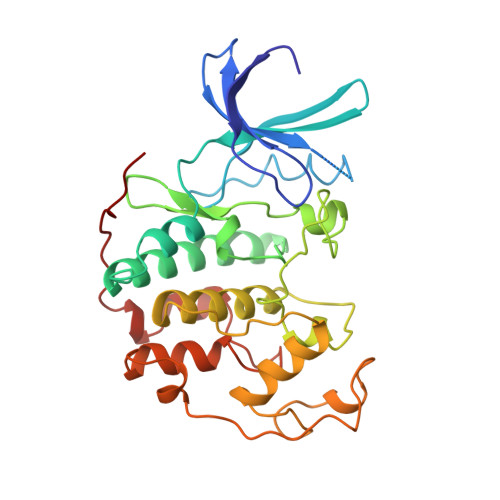Inhibition of cyclin-dependent kinases by purine analogues: crystal structure of human cdk2 complexed with roscovitine.
De Azevedo, W.F., Leclerc, S., Meijer, L., Havlicek, L., Strnad, M., Kim, S.H.(1997) Eur J Biochem 243: 518-526
- PubMed: 9030780
- DOI: https://doi.org/10.1111/j.1432-1033.1997.0518a.x
- Primary Citation of Related Structures:
2A4L - PubMed Abstract:
Cyclin-dependent kinases (cdk) control the cell division cycle (cdc). These kinases and their regulators are frequently deregulated in human tumours. A potent inhibitor of cdks, roscovitine [2-(1-ethyl-2-hydroxyethylamino)-6-benzylamino-9-isopropylpurin e], was identified by screening a series of C2,N6,N9-substituted adenines on purified cdc2/cyclin B. Roscovitine displays high efficiency and high selectivity (Meijer, L., Borgne, A., Mulner, O., Chong, J. P. J., Blow, J. J., Inagaki, N., Inagaki, M., Delcros, J.-G. & Moulinoux, J.-P. (1997) Eur. J. Biochem. 243, 527-536). It behaves as a competitive inhibitor for ATP binding to cdc2. We determined the crystal structure of a complex between cdk2 and roscovitine at 0.24-nm (2.4 A) resolution and refined to an Rfactor of 0.18. The purine portion of the inhibitor binds to the adenine binding pocket of cdk2. The position of the benzyl ring group of the inhibitor enables the inhibitor to make contacts with the enzyme not observed in the ATP-complex structure. Analysis of the position of this benzyl ring explains the specificity of roscovitine in inhibiting cdk2. The structure also reveals that the (R)-stereoisomer of roscovitine is bound to cdk2. The (R)-isomer is about twice as potent in inhibiting cdc2/cyclin B than the (S)-isomer. Results from structure/activity studies and from analysis of the cdk2/roscovitine complex crystal structure should allow the design of even more potent cdk inhibitors.
Organizational Affiliation:
Department of Chemistry, University of California, Berkeley, USA.















